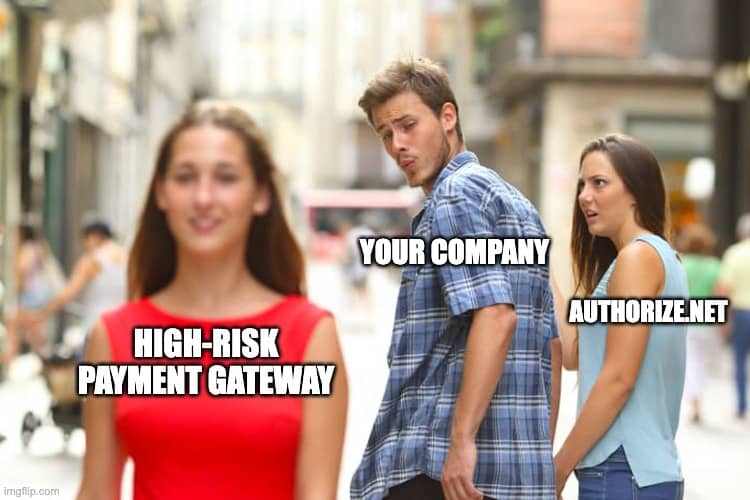What Is a Rolling Reserve?

Businesses that are considered high-risk are often subjected to a rolling reserve requirement. This phenomenon is considered typical for payment processing, and in most cases, it can’t be avoided.
But what is a rolling reserve, exactly? And how do business owners like you know if your business fits into that high-risk category? Let’s talk about it.
What Is a Rolling Reserve?
A rolling reserve is a type of non-interest-bearing subaccount that many high-risk businesses need to agree to as a part of their payment processing contracts.
In short, a portion of your credit card sales is held in reserve for a period to cover possible chargebacks. Eventually, those funds are released and deposited into your business bank account.
How Do Rolling Reserves Work, Exactly?
The term rolling reserves indicates how this type of account works.
For example, your merchant account provider may have you on a six-month rolling reserve. That means the amount of money withheld from your gross sales in the first month would be released to your bank account at the six-month mark.
The same thing happened the following month, and so on. That same percentage of your gross sales continues to be held in reserve and released on a schedule.
Rolling reserves are a way for merchant account providers to manage their risk for high-risk accounts.
What Are Typical Rolling Reserves Terms?
It really depends on your merchant account provider. For many, six months is common. But some credit card processors require 12 months. Others may only hold those funds for a few weeks.
As far as how much you can expect to be held in reserve, 5-10% is typical.
Do Rolling Reserve Requirements Ever End?
It depends.
Every merchant service provider is different. Some may require rolling reserves for a predetermined amount of time. Others may require them for all high-risk accounts with no end in sight.
Your business may need to prove itself to your merchant account provider. After 6-12 months, if you manage to keep your chargebacks low, they may offer to lower your reserve amount. If low chargebacks continue, they may be willing to remove it altogether.
Regardless, you should ask questions about rolling reserves if your business is in a high-risk industry. Not all providers are upfront about this aspect of their services, and you need to know what to expect.
What Is a High-Risk Merchant Account?
A high-risk merchant account is a type of business account specifically used for processing payments for businesses within this category. It is generally not possible to accept credit card payments without one.
Please note that this is not the same as your business bank account. That is where you receive funds from your sales. But those funds first go through a merchant account.
Here’s how it works:
- The customer swipes a card or enters their credit card information to pay for their order.
- The credit card company is contacted and asked to approve the sale.
- If approved, the money moves from the customer’s account and is directed to the acquiring bank, where it is deposited into the merchant account.
- From there, any processing fees and rolling reserve funds are removed.
- The balance is deposited into the business bank account.
High-risk merchant accounts typically require higher processing fees than standard merchant accounts. But it pays to have one instead of going through a payment aggregator, which carries risks of its own.
What Businesses Need Rolling Reserve Accounts?
Many industries are considered high-risk, and some on the following list might surprise you. But all of these may be required to have rolling reserve accounts:
- Cannabis dispensaries
- CBD stores
- Casinos
- Online gaming sites
- Pharmaceutical sales
- Tobacco and e-cigarette companies
- Travel businesses and timeshares
- Credit repair companies
- Cryptocurrency
- Telemarketing sales
- Adult websites and stores
- Dating websites
- Event Sales
Other factors come into play too. If any of the following is true about your business, you may need a high-risk merchant account:
- You have an average monthly sales volume of $20,000 or more.
- The average credit card transaction is $500 or more.
- You offer recurring payments on subscription.
- You offer digital products.
- You’re based in or selling to a high-risk country.
- You’re on the MATCH list for excessive chargebacks.
- You accept more than one currency for payments.
More Options for Credit Card Processing Reserves
Rolling reserves are common for high-risk merchant accounts. But there are other types of reserve accounts that some providers prefer.
Up-Front Reserves
In some cases, up-front reserves might be a better option for some businesses. This type of subaccount requires a one-time debit to your account for a larger sum of money.
This isn’t as common as rolling reserves. But if you have heavy cash flow and a high amount of operating capital, your merchant account provider may prefer it. Collecting advance payments (such as in ticket sales) may also make your business a candidate.
Don’t worry about up-front reserve accounts if you have a new business. Most new businesses cannot afford to have them, and your merchant account provider should work with you to find a solution that fits both of your needs.
Capped Reserves
Capped reserves are more common than up-front reserves. With this type of subaccount, a cap is set on your reserves subaccount. Once the amount withheld reaches the cap, no additional funds are held.
For instance, let’s say you have a capped reserve of $40,000. Your agreement with your merchant account provider states that they may withhold 10% of your sales until that reserve is reached.
Another example would be to have a percentage-based capped reserve that’s based on your monthly processing volume. In this scenario, the payment processing company would withhold a higher percentage of your sales (even 100%) until that cap is reached.
This type of reserve subaccount doesn’t always release funds on a “rolling” basis as rolling reserves do. The money is typically held until you close your merchant account with that provider.
Static Reserves
Static reserves are similar to rolling reserves, but with one important difference. With a static reserve, your merchant account provider will withhold a percentage of your gross sales up to a certain amount.
Once your sales that month reach that amount, there will be no additional withholdings until the following month.
This tends to be a more agreeable solution for many businesses, especially those just getting started.
Rolling Reserves: Pros and Cons
Rolling reserves aren’t all bad. In fact, there are some benefits. But it helps to know the pros and cons before you open your merchant account.
Pros:
- Agreeing to rolling reserves can help you get a merchant account for your high-risk business. If you don’t agree with this condition, it may be challenging to find a provider that will work with you.
- Rolling reserves are similar to savings accounts in a way. You’re being forced to put aside money, should you ever need it to cover chargebacks. This can save you from scrambling to come up with those funds in the future.
- Rolling reserves offer protection from fraud.
Cons:
- You’ll feel how your cash flow is affected because you’ll “lose” a percentage of each transaction.
- If you end up losing your merchant account, those funds may be held for six months due to the chargeback period.
Avoiding Rolling Reserves
There are ways to avoid rolling reserves, although you may want to tread carefully before considering them. Always consider all your options before you decide who will process payments for your business.
- Don’t Accept Credit Cards.
Nowadays, when about everyone uses credit cards to pay for products and services, it’s hard to imagine not accepting them. If you don’t, you could miss out on many sales.
But you don’t have to accept them for your business to be successful. A lot of high-risk businesses choose only to accept cash or mobile wallet payments like Google Pay and Apple Pay.
- Use a Payment Aggregator (Payment Service Provider)
Companies like PayPal, Stripe and Square make it super easy to start accepting payments. But don’t be fooled — if you choose this route, you’re putting your business at even greater risk.
In just a few clicks, and by providing a little information, you can start taking credit card payments with these companies. But instead of offering you your own dedicated merchant account, you’ll share one with many other businesses.
Because payment service providers carry so much risk, if anything goes wrong, you could risk having your account frozen. This can cause you to lose access to your funds for months or even years.
Also, many of these companies refuse to work with certain types of high-risk businesses. It may be tempting to be dishonest about your products to access their services. Please take our advice and avoid this at all costs.
- Work With a Credit Card Processor That Can Help You Save Money
The best merchant account providers understand the frustrations high-risk businesses have with rolling reserves. While they may still require them, they have other ways to help them save money.
It helps to work with a processor that lets you take multiple forms of payment. There are also ways to prevent chargebacks, and many merchant account providers have programs in place to help with that.
Frequently Asked Questions
What is a chargeback?
A chargeback is when a charge is returned to a credit or debit card following a customer’s dispute. Most of the time, chargebacks are the result of fraud. But sometimes, customers will dispute charges for purchases they intentionally made.
In the United States, the law states that customers have a minimum of 60 days to file a chargeback. However, most banks will allow 120 days to file.
What types of credit cards are impacted by rolling reserves?
Rolling reserves only apply to Visa and Mastercard transactions. They do not apply to Discover, American Express, or any other credit card or payment method.
Why is six months a common timeframe for rolling reserves?
Six months (or 120 days) is the typical timeframe for rolling reserves because of the chargeback period allowed by most banks. Once six months have passed, the merchant account provider is no longer at risk of losing money on those sales.
Is it possible to have more than one merchant account to avoid rolling reserves?
Many payment processing companies offer high-risk businesses more than one merchant account. This helps reduce their risk and gives them protection in case one merchant account receives a lot of chargebacks.
However, you shouldn’t depend on that as a way to avoid having rolling reserves. That requirement may still be in place because the risk for your merchant account provider remains the same.
How can you prepare for a rolling reserves requirement?
You’re taking an important step in preparing for rolling reserves just by reading this article. But we also highly recommend the following:
- Talk with your merchant account provider and get a clear understanding of their rolling reserves requirement. Find out how much will be withheld and when funds will be released.
- Take a close look at your cash flow to determine anticipated sales vs. your operating expenses. Will you be able to make a profit with a rolling reserve account in place? If not, you may need to make some adjustments.
- Consider the long-term effects and plan for a shortfall in sales.
Final Thoughts
Unfortunately, rolling reserves are often par for the course for high-risk businesses. But at Zenti, we know how important it is for you to save money and keep your payment processing costs as low as possible.
We’re fully prepared to work with you and discuss your options for rolling reserves. We even have services in place to help you reduce your costs in other ways, which will put more money back in your pocket.
We offer chargeback prevention services and many helpful tools to help protect your merchant account.
Do you have a high-risk business that needs a merchant account? Contact Zenti, and let’s talk about how we can help.
Read Next

Find out whether Authorize.Net works for high risk merchants, what restrictions you might face and how to get approved.

Get expert advice on selling CBD products on Shopify, including compliance tips and setting up secure payment options.

Find out why Square may deactivate merchant accounts and steps to resolve issues and maintain uninterrupted payment services.
Need a High-Risk Merchant Account?
Disruption-free payment processing at the best price for your situation, guaranteed.
Get Free Guidance Now!